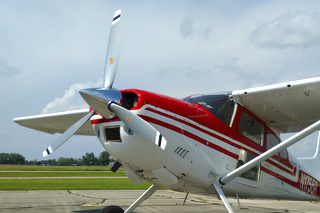
There are many good reasons to consider replacing and upgrading your airplane propeller. Many aircraft owners choose to swap their legacy prop with a next-generation design when it’s nearing overhaul time. Others opt to do an engine and propeller conversion all at once. Whatever the reason, a propeller conversion is one of the smartest investments you can make for your aircraft. Before selecting a new propeller for your airplane, consider the following questions:
What’s your mission profile?
When selecting a propeller, it’s important to have a clear understanding of your typical flight mission. Where do you fly most often, and why? Do you make $100 hamburger runs on the weekends or longer cross-country trips? What weather and terrain do you frequently encounter? Keeping this information in mind will help you find the right propeller to fit your most common mission profile.
What problems are you looking to solve?
Next, consider the problems you hope to solve with a new propeller. Do you need to lower noise levels or reduce weight? Do you want to change from wheels to floats or skis? Are you looking to reduce takeoff distance, improve climb rate, or increase cruise speed? Decide what factors matter most to you and narrow down your options.
What kind of propeller blade material is best for you — aluminum or composite?
When selecting a new aircraft propeller, you will generally have three options in terms of blade material: wood, metal (usually aluminum alloys), and composite. At Hartzell, our propeller blades are made from high strength aluminum alloy forgings or advanced structural composite materials. While aluminum blades are usually a lower upfront cost, composite blades offer significant advantages over their aluminum counterparts, including a substantial weight reduction, better durability, and enhanced performance. But perhaps the best advantage of our composite blades is their ability to maintain a more optimal airfoil shape over the life of the blade.
The overhaul process for aluminum props involves removing permanent material by grinding or filing down the blade, whereas composite blades are repaired by replacing the material that was lost to nicks or gouges. This means that unlike aluminum blades, composites can be repaired and returned to service multiple times without adversely affecting the airfoil shape. Additionally, small repairs between overhauls can be made with little or no assistance from a prop shop, helping owners save money and reduce aircraft downtime.
What is the warranty?
An aircraft propeller conversion is a significant upfront expense, so it’s well worth it to choose a prop that can go the distance. Choosing a propeller that offers a long service life and extended warranty can help to reduce the cost of flying and protect the value of your investment for years to come.
If you’re ready to replace your legacy prop and upgrade to a next-generation propeller, check out Hartzell Propeller’s Top Prop Conversion Program. Our purpose-designed propellers are engineered to optimize the performance and efficiency of specific aircraft types, including Beechcraft, Cessna, Piper, Pilatus, Daher TBM, and more. We make the propeller conversion process easy for owners by supplying the STC paperwork, new prop, and spinner.
Best of all, our Top Prop conversions are covered under the longest warranty for propellers available anywhere in the general aviation industry, all the way through the first overhaul. Our innovative extended warranty program helps pilots save on flying costs and encourages safety through recommended periodic maintenance.
Learn more about Hartzell Propeller’s Top Prop conversion program or contact us to speak to our technical specialists about your propeller needs. We’re happy to help you find the best propeller system to match your aircraft and mission.